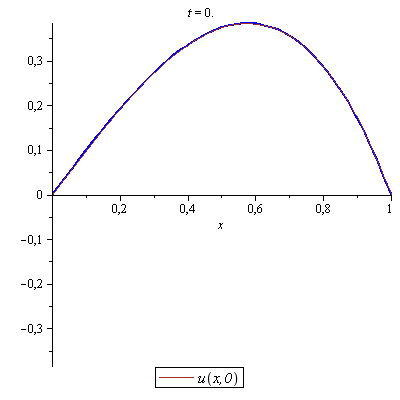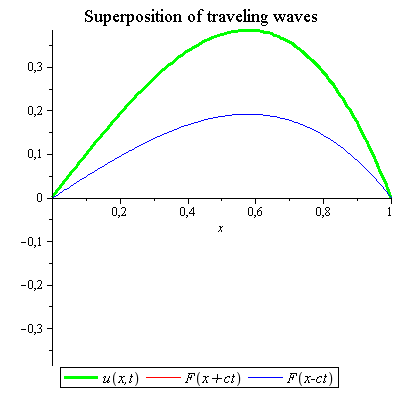D'Alembert's Method
The wave equation
![]()
can be put into the form
![]()
by means of the substitutions
![]() and
and ![]()
Integrating with respect to ![]() and with respect to
and with respect to ![]() shows that
shows that
![]()
![]()
![]()
![]()
where ![]() and
and ![]() are arbitrary twice-differentiable functions,
are arbitrary twice-differentiable functions,
is a solution of the wave equation and is known as d'Alembert's solution, named after the French mathematician Jean le Rond d'Alembert (also educated in law and medicine).
The two functions ![]() and
and ![]() can be determined using the initial conditions
can be determined using the initial conditions
![]() and
and ![]()
d'Alembert's Solution
The solution of the one dimensional wave equation
![]() ,
, ![]()
with initial conditions
![]() and
and ![]() for
for ![]()
and boundary conditions
![]() and
and ![]() for all
for all ![]()
known as d'Alembert's solution is given by
![]()
![]()
![]()
![]()
![]()
![]()
![]()
![]() where
where ![]()
![]()
![]() and
and ![]() denote the odd extensions of
denote the odd extensions of ![]() and
and ![]()
![]() is some fixed number.
is some fixed number.
d'Alembert's Solution
-
pdsolve
 gives d'Alembert's solution
gives d'Alembert's solution  of the wave equation given by
of the wave equation given by 
-
dAlembert
 animates d'Alembert's solution of the wave equation during the time
animates d'Alembert's solution of the wave equation during the time  .
.  is the number of frames
is the number of frames
Example 3
a) Derive d'Alembert's solution by determining the two arbitrary functions in the general solution using the initial conditions ![]() and
and ![]()
b) Solve the one-dimensional wave equation with ![]() for a string of length
for a string of length ![]() with zero initial velocity and a profile given by
with zero initial velocity and a profile given by![]()
![]()
![]()
![]()
![]()
![]()
![]()
Illustrate the motion of the string by animation and compare it by d'Alembert's solution.
Solution
| > | restart:MathMaple:-ini(): |
a) The wave equation is
|
The d'Alembert's solution is
|
|||||||||||||||
|
|
|||||||||||||||
d'Alembert's solution satisfying the initial conditions
|
|
|||||||||||||||
Integrating gives
|
|
|||||||||||||||
Solving for
The solution of
is then
|
||||||||||||||||
b) The solution is given by
|
||||||||||||||||
|
|
|||||||||||||||
Click and start the animation. |
The approximated solution above using 10 partial sums was Using 100 partial sums, we get
|
 = `+`(`/`(`*`(`/`(1, 2), `*`(`+`(`*`(c, `*`(f(x))), int(g(s), s = a .. x)))), `*`(c))), F[2](`+`(`-`(x))) = `+`(`/`(`*`(`/`(1, 2), `*`(`+`(`*`(c, `*`(f(x))), `-`(int(g(s), s = a .. x))))), `*...](images/Some Pages_1015.gif)



